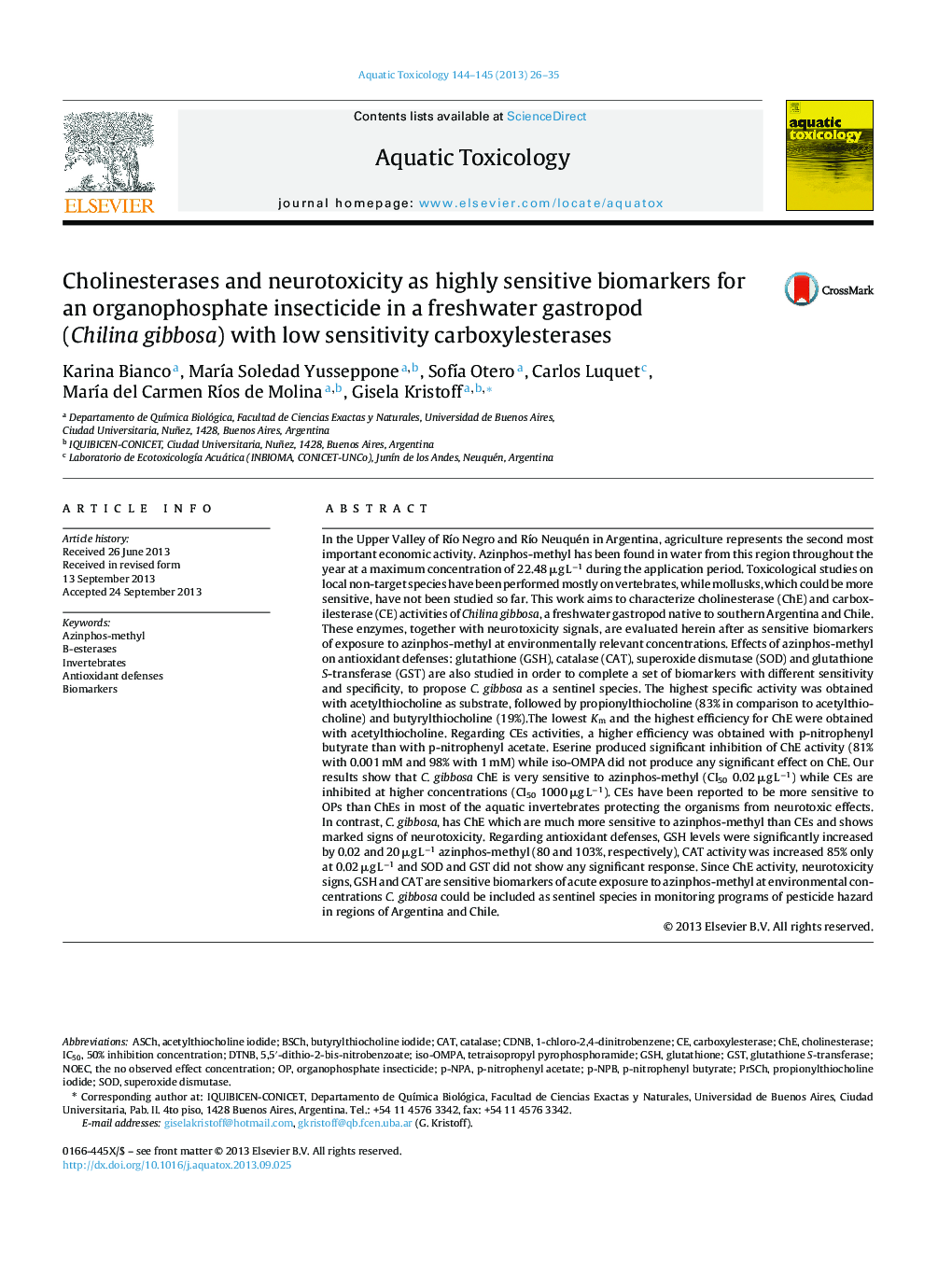| کد مقاله | کد نشریه | سال انتشار | مقاله انگلیسی | نسخه تمام متن |
|---|---|---|---|---|
| 4529333 | 1625960 | 2013 | 10 صفحه PDF | دانلود رایگان |

• Cholinesterases of C. gibbosa are very sensitive to azinphos-methyl.
• Carboxylesterases are no inhibited at environmental concentrations.
• Azinphos-methyl causes signs of neurotoxicity and increase glutathione and catalase.
• C. gibbosa could be included as sentinel in monitoring programs of pesticide hazard.
In the Upper Valley of Río Negro and Río Neuquén in Argentina, agriculture represents the second most important economic activity. Azinphos-methyl has been found in water from this region throughout the year at a maximum concentration of 22.48 μg L−1 during the application period. Toxicological studies on local non-target species have been performed mostly on vertebrates, while mollusks, which could be more sensitive, have not been studied so far. This work aims to characterize cholinesterase (ChE) and carboxilesterase (CE) activities of Chilina gibbosa, a freshwater gastropod native to southern Argentina and Chile. These enzymes, together with neurotoxicity signals, are evaluated herein after as sensitive biomarkers of exposure to azinphos-methyl at environmentally relevant concentrations. Effects of azinphos-methyl on antioxidant defenses: glutathione (GSH), catalase (CAT), superoxide dismutase (SOD) and glutathione S-transferase (GST) are also studied in order to complete a set of biomarkers with different sensitivity and specificity, to propose C. gibbosa as a sentinel species. The highest specific activity was obtained with acetylthiocholine as substrate, followed by propionylthiocholine (83% in comparison to acetylthiocholine) and butyrylthiocholine (19%).The lowest Km and the highest efficiency for ChE were obtained with acetylthiocholine. Regarding CEs activities, a higher efficiency was obtained with p-nitrophenyl butyrate than with p-nitrophenyl acetate. Eserine produced significant inhibition of ChE activity (81% with 0.001 mM and 98% with 1 mM) while iso-OMPA did not produce any significant effect on ChE. Our results show that C. gibbosa ChE is very sensitive to azinphos-methyl (CI50 0.02 μg L−1) while CEs are inhibited at higher concentrations (CI50 1000 μg L−1). CEs have been reported to be more sensitive to OPs than ChEs in most of the aquatic invertebrates protecting the organisms from neurotoxic effects. In contrast, C. gibbosa, has ChE which are much more sensitive to azinphos-methyl than CEs and shows marked signs of neurotoxicity. Regarding antioxidant defenses, GSH levels were significantly increased by 0.02 and 20 μg L−1 azinphos-methyl (80 and 103%, respectively), CAT activity was increased 85% only at 0.02 μg L−1 and SOD and GST did not show any significant response. Since ChE activity, neurotoxicity signs, GSH and CAT are sensitive biomarkers of acute exposure to azinphos-methyl at environmental concentrations C. gibbosa could be included as sentinel species in monitoring programs of pesticide hazard in regions of Argentina and Chile.
Journal: Aquatic Toxicology - Volumes 144–145, 15 November 2013, Pages 26–35